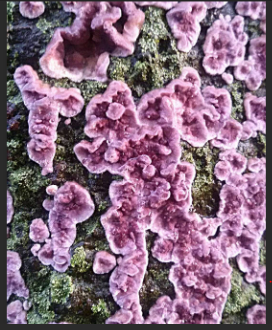
Curious case of Chondrostereum purpureum , 'world-first case' of infection of this fungus in Humans.
Recently one news have caught my attention ( https://news.sky.com/story/killer-plant-fungus-Chondrostereum-purpureum-infects-man-in-india-in-world-first-case-12844978) .
A mycologist of Kolkata (India) who was working with mushrooms and various other plant fungi is found infected with plant fungus Chondrostereum purpureum , which apparently is 'world-first case' of infection of this fungus in Humans.
Chondrostereum purpureum causes silver leaf disease in flora, most commonly in various species of rose.
Although there are few other plant pathogens which reported earlier and can infect Humans ( like Alternaria infectoria , Bipolaris spicifera , Fusarium graminearum Fusarium proliferatum , many species of Cladosporium ), ( Reference Environmental Microbiology (2020) 22(7), 2485–2495).
But the matter of concern is that as the planet warms up due to climate change, known and unknown fungi could emerge as potential threats as they learn to survive on a hotter planet.
Recently the World Health Organization (WHO) listed 19 it fears could become a threat to public health(WHO fungal priority pathogens list to guide research, development and public health action). Following is the list of Fungi in the WHO guidance document.
Thermotolerant Cryptococcal species express virulence factors, like polysaccharide capsule and melanization . In this case, the acquisition of thermotolerance presumably increases their potential to become pathogenic. Cryptococcus laurentii, which normally does not grow at 37°C, but thermotolerant strains have increasingly been associated with disease in extremely immunosuppressed hosts .
Is this case of Chondrostereum-purpureum is raising alarm bells for emergence of new challenge ?? and If the hypothesis propounded in the following reference is true ( reference : Garcia-Solache, M. A., and A. Casadevall. 2010. Hypothesis: global warming will bring new fungal diseases for mammals. mBio 1(1):e00061-10. doi:10.1128/mBio.00061- 10.) global warming might increase the prevalence of fungal diseases in mammals by two mechanisms: (i) increasing the geographic range of currently pathogenic species and (ii) selecting for adaptive thermotolerance for species with significant pathogenic potential but currently not pathogenic by virtue of being restricted by mammalian temperatures.
In summary We must keep out basic research done on this immerging area so that we can meet the challenge of providing heath care solutions to Humanity in future .
Military Veteran with Corporate experience | Capital Program/Project Management | Aerospace & Defence | MRO | Operations Managment
1yRajeev Kumar Seen the news last week! Good that you have drawn the necessary focus on its potential threat to humanity from plant fungus.